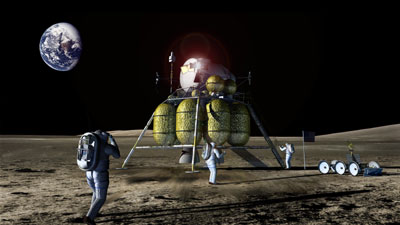Could the X Prize Cup help NASA develop a Lunar RLV?by Taylor Dinerman
|
| It seems that the second part of the competition is oriented towards developing a Lunar RLV. |
If NASA and the X Prize Foundation can keep the prize money flowing for this contest for the next ten or more years, they will help create a cadre of experts and entrepreneurs dedicated to building rocket craft that can operate from the surface of the Moon and go not only into lunar orbit or to hop around the surface, but such craft might even be capable of traveling around the Earth- Moon System.
If NASA keeps to its current plan, they will fly the first “Outpost Mission” in 2022 or 2023. These are by far the most important NASA missions of the first half of the 21st century. The goal is to begin work on what will become a permanent base on the Moon. In time this will evolve into the starting point for lunar colonization and development. To accomplish this NASA hopes to show that it can “live off the land” using In Situ Resource Utilization (ISRU) technology, especially to provide the Moon base with a source of rocket fuel.
If the US can build a vehicle, or class of vehicles, that can reliably and safely launch from the Moon into Lunar orbit and support travel to places such as the Lagrange points or either low Earth orbit (LEO) or geosynchronous orbit (GEO), it will be well on its way to attaining a strong position in the future economy of cislunar space. A new space transportation system using the Crew Exploration Vehicle (CEV) and the Lunar RLV together will provide the US with something that might be thought of as a “manned space maneuver architecture”. The Lunar RLV could provide a growth version of the CEV with enough power and fuel to move easily from Lunar orbit to any point of interest within the Earth-Moon system.
For the moment, NASA and the Defense Department have given up on developing RLVs that can launch from the surface of the Earth to LEO. One reason that is often given is that they did not see how anyone could, in the near term, overcome the mass fraction problem. Unfortunately for the space launch industry, any rocket that wants to reach orbit must begin its ascent with 90% of its weight in fuel and oxygen. They overcome this by having the stages of their vehicles drop off on the way up. This process is sometimes referred to as “feeding very expensive bits of metal to the fish.”
On the Moon things are different. The ascent stage of the Apollo-era Lunar Excursion Module (LEM) weighed about 4,500 kg and its fuel weighed about 2,300 kg, i.e. a mass fraction of about 50%. This is far more manageable than the 90% needed to escape from Earth’s gravity. The designers of a Lunar RLV will have more available mass for the vehicle’s structure and payload than those working on its terrestrial equivalent.
According to the Exploration Systems Architecture Study (ESAS), the Lunar Surface Access Module (LSAM) will ascend using a new liquid oxygen/methane power engine designed to be “ISRU compatible”. A few of the ideas and technologies developed for the Suborbital Lunar Lander Analog Challenge may find their way into the LSAM. Certainly some of the people involved in the teams that will compete for the prize will gain valuable expertise that will feed into the whole Lunar exploration technology development process.
| The goal should remain a Lunar RLV that will be a reliable and economical workhorse for the mid to late 21st century. |
In spite of the low gravity, the challenges facing those who want to build a Lunar RLV will be huge. The environment is the most unforgiving and dangerous one imaginable. Dust and small rocks will be a constant hazard, kicking up debris every time the rocket engine is ignited. At least until some sort of pad or hard stand can be built, and even then exploration missions will still face the foreign object damage problem. The underside of the vehicle will have to be built with this in mind.
Far better radiation shielding than was available for Apollo will also be needed. For an Earthbound competitor this will not be a problem, at least not at first. It might, however, be wise to begin planning for future competitions to include a requirement that each team must take this into account. The vehicle will also have to have a life support system at least as good as the one on the LSAM, one that can provide a weeks’ worth of air, water, and food; it will also have to have the same kind of airlock.
Moving from the LSAM to the Lunar RLV will take a positive decision by NASA and by the White House and Congress. The plan, as its stands now, is for the LSAM to be developed between the years 2010 and 2018. It would seem natural that Lunar RLV development begin immediately after the LSAM becomes operational. The knowledge gained by the space industry from this Centennial Challenge competition will provide a base of information for the decisionmakers. NASA should plan to keep this annual event going right up until the 2018 timeframe. The rules of the competition can change or be refined, but the goal should remain a Lunar RLV that will be a reliable and economical workhorse for the mid to late 21st century.
